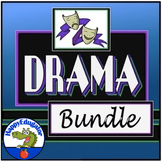Introduction to Drama PowerPoint
- PPTX
- Microsoft OneDrive
Also included in
- This bundle of drama unit resources and role play activities is a fun and interactive way to get students involved in the study of theater, and they will enjoy the drama lessons and activities included. Students will learn all about the elements of drama in the introductory PowerPoint, including thePrice $26.40Original Price $33.00Save $6.60
Description
This Drama PowerPoint is an excellent introduction to theater and drama lesson you project on your whiteboard to start teaching and hook your students. Presentation has animations, sounds, and graphics that engage students when starting a drama unit. Defines drama terms like playwright, stage directions, set, props, script, etc. Includes staging, dramatization, how plays are produced, the role of the audience and theater etiquette. Also includes information on Greek theater, Shakespearean theater, and Modern theater.
Use PowerPoints like this in Zoom for remote learning. Share with students in OneDrive or Teams, too. Just view in Slideshow mode. Upload to Google Drive and save as Google Slides. It will automatically convert for use in Google Classroom. It is EDITABLE and easy to make adjustments if necessary. Please see full preview. Note: animations do not show in preview.
For easy notetaking, print out the slides with notes pages which is a great PowerPoint feature. When you go to print, select settings, and then you can select the three slides per page with lines for notetaking.
If you would rather have the Google Slides version ready to go for distance learning, you can get it here:
Introduction to Drama Google Slides Lesson Distance Learning
(Note: the Google Slides version does not have audio)
Included in my Drama Resource Bundle. Buy the bundle and save!
You may also like:
Drama - Play Knowledge Extensions Menu
Drama Role Play Activities and Warmups
Drama - Play Outline for Play Writing Project
Drama - Extension Activities PowerPoint
(Which includes five different menu choice boards)
Follow me HERE to get notified of updates, sales, free resources, and new products. All new products are 50% off for 48 hours.
© Deborah Hayes aka HappyEdugator. For classroom and homeschool use. Y our purchase buys one license. You may purchase extra licenses at a discount.
Supports Common Core State Standards in Language Arts. CCSS:
CCSS.ELA-Literacy.RL.6.7 Compare and contrast the experience of reading a story, drama, or poem to listening to or viewing an audio, video, or live version of the text, including contrasting what they “see” and “hear” when reading the text to what they perceive when they listen or watch.
CCSS.ELA-Literacy.RL.7.7
Compare and contrast a written story, drama, or poem to its audio, filmed, staged, or multimedia version, analyzing the effects of techniques unique to each medium (e.g., lighting, sound, color, or camera focus and angles in a film).
CCSS.ELA-Literacy.RL.8.7
Analyze the extent to which a filmed or live production of a story or drama stays faithful to or departs from the text or script, evaluating the choices made by the director or actors.
53944






